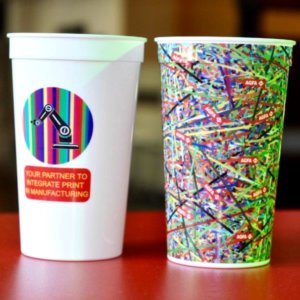






 UV inkjet printing is the ideal solution for printing ‘direct-to-shape’. It perfectly matches the trends and needs of the growing packaging market: shorter product cycles, customization & variation, and less waste.
UV inkjet printing is the ideal solution for printing ‘direct-to-shape’. It perfectly matches the trends and needs of the growing packaging market: shorter product cycles, customization & variation, and less waste.
UV inkjet printing is not limited to typical sign & display jobs. It is also suited for many other applications, where print is part of the product, e.g. a phone cover. For these ‘industrial printing’ applications, both wide-format printing (multi-pass printing) and single-pass printing solutions are being used. The reach for industrial printing is growing every day, as new possibilities are being explored, tested and implemented.
Meeting the needs of the packaging market
The packaging market is a growing business segment facing two major demands: 1/ shorter product cycles, lower cost, and waste, 2/ increased commitment to the brand owner by stronger consumer engagement by the packaging. Digital printing is not hampered by considerable set-up times and is more suitable for shorter run lengths, mass customization and variations.
The packaging world is also a much-segmented market, where a wide range of materials is used in many different shapes. This requires printing solutions that either print during a pre-step (e.g. printing on roll or sheets), or that print ‘direct-to-shape’ on the packaging in its final format. The ultimate solution comprises dedicated printing machinery, which is precisely adapted to the container shape and ink, which is tuned to the printing system and to the functional needs of the specific container.
This is where UV inkjet printing enters the stage. UV inks allow for printing directly on the container, without the need of a label or an ink-receiving layer or primer. Applications include direct printing on containers for general non-food related products, as well as for food and beverage packaging. However, both types of applications require a dedicated UV ink design.
The digital printing process can be in-line or off-line, in or close to the packaging line or at a nearby partner. There is only a short set-up time as there is no need of a master. Run lengths can be fully variable taking into account the exact print amounts needed. Also printing just-in-time becomes possible.
Last but not least, the brand owner and the consumer take benefit from digital printing through improved versioning, easy communication in different languages, health information, and customization.
UV inkjet inks for printing directly on the container.
Inkjet inks require low viscosity to be able to be jetted through the small nozzles of the print head. It has been proven that UV inkjet inks can fulfill the functional specifications of image quality, adhesion and scratch resistance. Depending on the substrate, adhesion can be tuned by in-line pre-treatment (plasma, flame or corona). High performant UV inkjet inks not only deliver the above but also deliver reliable print results, print-by-print, day-by-day. Examples include printing on soft plastic tubes, rigid plastic tubes, and aerosol cans.
In the specific case of food or beverage containers, printed bottles or containers must comply with food safety regulations according to legislations and guidelines. Given direct printing alternatives are designed with a full solution approach, which includes the use of dedicated low migration UV inkjet inks, such solution can be used for food safe packaging.
Agfa Low Migration UV inks are formulated and produced according to these guidelines, thanks to a patented ink technology that guarantees a high degree of polymerisation and low migration of the ink compounds. Agfa LM UV inkjet inks are based on the combination of low viscous yet highly reactive monomers with diffusion-hindered photo-initiators. Inherent to the design of these LM inks is the very high degree of polymerization while migration is low.
Today Agfa’s LM UV inkjet inks are used for many different types of direct printing on primary food packaging (on the non-contact side). They are designed for high image quality, good physical properties, and food safety. Examples include direct printing on PET bottles, plastic food/beverage containers (polypropylene substrate) and direct print on HDPE (High-Density Poly Ethylene) closure caps. These applications require the correct combination of the print system and Agfa’s LM inks to meet the various functional requirements.
Prepared on the basis of Industrial Print Blog